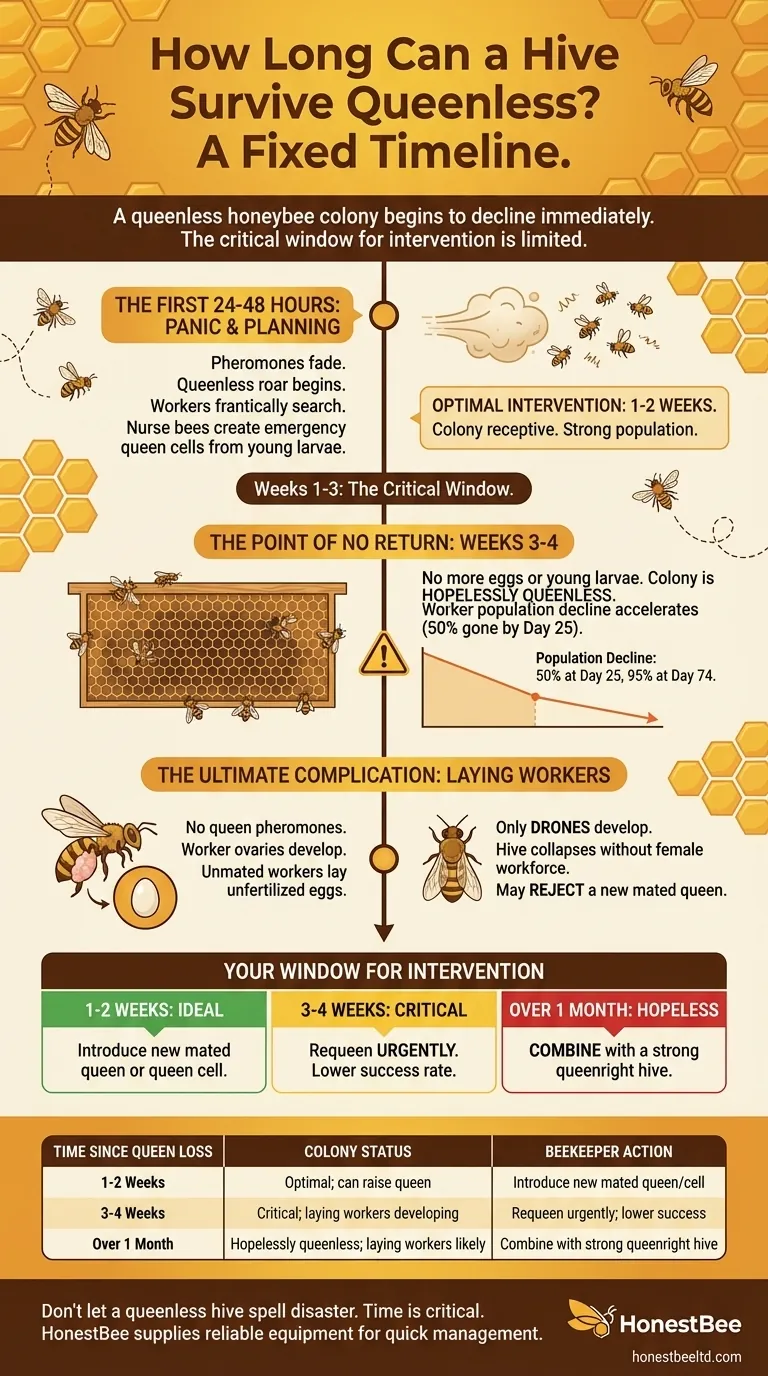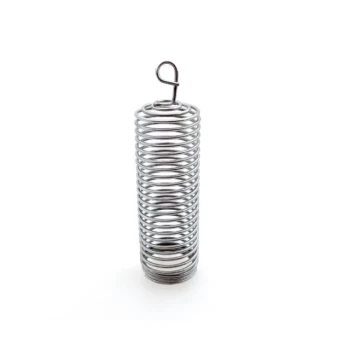A queenless honeybee colony is on a fixed timeline. While some workers can survive for many weeks, the colony as a functioning unit begins to decline immediately. Data shows that roughly 50% of the worker population will be gone in about 25 days, with 95% perishing by day 74, at which point the colony is no longer viable.
A hive's survival is not measured by how long the last worker bee lives, but by the critical window of opportunity a beekeeper has to intervene. The true countdown is to the point where the colony can no longer raise a new queen or accept one, typically around three to four weeks.

The Cascade of Colony Failure
When a hive loses its queen, it doesn't simply wait to die. A series of predictable biological events unfolds, creating a clear timeline for beekeepers. Understanding these stages is critical to a successful intervention.
The First 24-48 Hours: Panic and Planning
Immediately after the queen disappears, the pheromones she produces begin to fade. The colony's mood shifts noticeably.
The hive's cohesive, gentle hum often changes to a louder, more agitated "queenless roar." This is the first audible sign that something is wrong. Workers will begin a frantic search for their queen.
Almost simultaneously, nurse bees identify the youngest female larvae (ideally 1-3 days old) and begin feeding them copious amounts of royal jelly. This specialized diet is what transforms a standard worker larva into a potential new queen. These modified cells are known as emergency queen cells.
The Critical Window: Weeks 1-3
This period determines whether the colony can save itself. If the hive has fresh eggs or very young larvae, it has the raw material needed to create a new queen.
This is the optimal time for a beekeeper to intervene. The colony is highly receptive to a new mated queen or a viable queen cell. The population is still strong, and the hive's social structure is intact.
The Point of No Return: Weeks 3-4
By the third week, any brood left by the old queen will have hatched. If the bees were unable to raise a new queen, the hive is now considered hopelessly queenless. There are no more eggs or young larvae to use for another attempt.
The worker population, with no new bees emerging, begins its irreversible decline. This is when the 50% population loss around day 25 becomes a stark reality.
The Ultimate Complication: Laying Workers
The absence of queen pheromones for several weeks triggers a last-ditch, dysfunctional survival mechanism in the colony.
The Rise of Anarchy
Without the queen's chemical signals suppressing their reproductive systems, some worker bees' ovaries will develop. They will begin to lay eggs.
However, because these workers are unmated, they can only lay unfertilized eggs. These unfertilized eggs develop exclusively into male bees, or drones.
Why This Spells the End
A hive cannot survive on drones. It needs female worker bees to forage, raise young, and defend the colony. A hive dominated by laying workers will slowly fill with useless drones until it collapses.
Critically, a hive with laying workers will often reject and kill a new, healthy queen introduced by a beekeeper. They perceive their own dysfunctional laying workers as the "queen," making rescue extremely difficult.
Your Window for Intervention
Your response to a queenless colony must be dictated by how long it has been in that state. Time is the most critical factor.
- If you suspect queenlessness within 1-2 weeks: This is the ideal scenario. Your goal is to confirm the absence of a queen and eggs, then introduce a new mated queen or a viable queen cell as soon as possible.
- If the hive has been queenless for 3-4 weeks: You must act with extreme urgency. The colony is declining, and laying workers may be developing. Requeening is still possible but has a lower chance of success.
- If the hive has been queenless for over a month: The colony is likely too weak and may have active laying workers, making it unable to recover on its own. The best course of action is often to combine the remaining bees with a strong, queenright colony to save the workforce.
Understanding this timeline transforms a crisis into a manageable problem, empowering you to act decisively and save your colony.
Summary Table:
| Time Since Queen Loss | Colony Status | Beekeeper Action |
|---|---|---|
| 1-2 Weeks | Optimal for intervention; can raise a new queen. | Introduce a new mated queen or queen cell immediately. |
| 3-4 Weeks | Critical decline; laying workers may develop. | Requeen with urgency; success rate is lower. |
| Over 1 Month | Hopelessly queenless; likely has laying workers. | Combine remaining bees with a strong queenright hive. |
Don't let a queenless hive spell disaster for your apiary. Time is the most critical factor in saving your investment. For commercial beekeepers and equipment distributors, every colony counts. HONESTBEE supplies the reliable, high-quality beekeeping equipment and supplies you need to manage your hives effectively and respond quickly to emergencies like queenlessness.
Ensure your operation is prepared. Contact our experts today to discuss your wholesale needs and keep your colonies thriving.
Visual Guide

Related Products
- Jenter Queen Rearing Kit Complete Set for Bee Breeding
- No Grafting Queen Rearing Kit: System for Royal Jelly Production and Queen Rearing
- Nicot Queen Rearing Kit for Beekeeping and Grafting in Nicot System
- JZBZ Langstroth Queen Rearing Frame for Beekeeping
- Durable Galvanized Steel Spring Queen Bee Cage
People Also Ask
- How can beekeepers start a honey bee breeding program? Build a Superior, Resilient Apiary
- How long does it take for a new queen to emerge, mate, and lay eggs? A Beekeeper's 10-14 Day Guide
- What were the size differences among queens reared from worker larvae? Maternal Origin Determines Queen Size
- What genetic pathways differ in QE-queens? Unlocking the Master Controls of Queen Bee Biology
- Why is raising queens beneficial for beekeepers? Gain Control Over Genetics and Costs



















